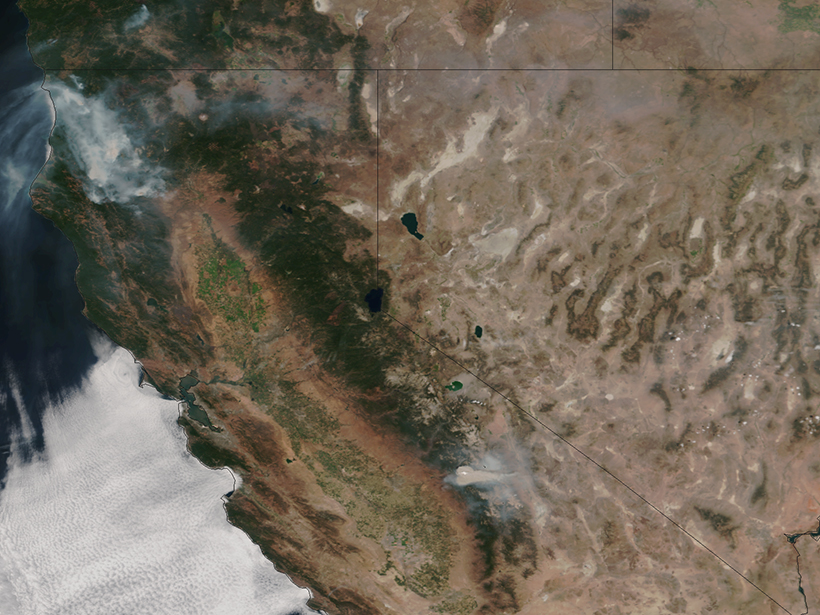Predicting how a wildfire is going to spread is extremely difficult. Fire behavior depends on many factors, such as wind speed and direction, type of terrain, and amount of fuel available.
Although firefighters have traditionally relied on their experience and intuition to determine how to react during fires, computer models are starting to be reliable enough to be used to predict how a fire will evolve and help in the decision-making process during suppression efforts.
Adam Kochanski, an atmospheric scientist at the University of Utah in Salt Lake City, has worked for years in the development of one of these models, coupling a widely used weather forecast model (the Weather Research and Forecasting Model, or WRF) with a model that simulates how fire spreads (SFIRE).
Recently, Kochanski updated his model so it can also simulate smoke dispersion and chemistry (CHEM). The inclusion of fire-smoke-atmosphere feedback within this framework, WRF‐SFIRE‐CHEM, may help guide wildfire suppression efforts in the future.
Testing a Case Study in California
During the summer of 2015, several fires ravaged northern California. Firefighters noticed that in certain valleys smoke tended to become thicker and took longer to disperse than in the surrounding open areas. Sometimes, the visibility was so poor that air support could not approach these areas, slowing operations and increasing the risk to ground units.
Thanks to surface meteorological stations, Kochanski and his colleagues noticed that the temperatures at ground level were much lower than those above the smoke. This finding pointed to a phenomenon called inversion in which large bubbles of cold air are trapped near the ground by masses of warm air above.

“Normally, air temperature decreases with an increase in altitude. However, the aerosols in wildfire smoke reduce the incoming solar radiation,” Kochanski said. “Smoke aerosols are the key players, as they absorb and scatter incoming solar radiation, reducing surface heating.”
Positive Feedback
Although this cooling effect had already been observed in the past, researchers were able to simulate how the process works, finding that there is a feedback loop that reinforces the atmospheric inversion conditions.
As smoke blocks incoming solar radiation from reaching the ground inside the valley, the air near the surface cools down and becomes denser, more static, and less likely to mix with the warm air above. As the fire continues to generate smoke, more sunlight is blocked, and the inversion is reinforced.
Simulations showed that wildfire smoke reduced local surface temperatures inside valleys by up to 3°C, in agreement with available measurements from surface stations.
Kochanski’s simulations showed that this mechanism works as long as there is sunlight above. “During the afternoon hours, surface temperatures reach maxima, so the effect of smoke shading is most pronounced, but smoke shading takes place as long as there is sunlight,” he said.
The simulations showed that wildfire smoke reduced local surface temperatures inside valleys by up to 3°C, in agreement with available measurements from surface stations.
According to Kochanski, only three things can break these fire inversions. Strong winds can forcibly mix the air layers, rains can scrub the smoke aerosols out of the air, and (once the fire stops) smoke will eventually disperse, and sunlight will be able to warm the surface again.
These findings are detailed in a study in the Journal of Geophysical Research: Atmospheres.
Daeok Youn, an expert in atmospheric modeling at the Chungbuk National University in South Korea, said that researchers have long speculated about how wildfire smoke can affect atmospheric radiation, stability, inversions, and circulation. But the present study, he said, quantitatively assesses and compares these impacts with the available observations. Youn was not involved in the present study.
“I am very happy to see this big advance in the modeling study of fire impacts on the atmosphere,” Youn said.
Modeling for the Future
“The most challenging part of the coupled fire-atmosphere modeling is that it requires a realistic representation of local weather, fuel conditions, [and] fire behavior, as well as interactions between them.”
To properly simulate wildfires and the smoke they generate, researchers need to account for not only large-scale parameters such as weather and terrain but also small-scale processes affecting the behavior of fire and its smoke plume. These small-scale processes include fire progression, how much smoke a fire causes, and even how moist the fuel (in this case, the forest) is.
“The most challenging part of the coupled fire-atmosphere modeling is that it requires a realistic representation of local weather, fuel conditions, [and] fire behavior, as well as interactions between them,” Kochanski said. “That is particularly difficult due to very limited observations collected in the wildland fire environment, which could be used for model development and validation.”
Although some of these models have been used to provide forecasting support during wildfires, Kochanski expects that smoke predictions will be available to suppression teams soon. “We just started a project focused on its prototype deployment, and we hope that it will benefit from our work presented in this study,” he said.
—Javier Barbuzano (@javibarbuzano), Freelance Science Journalist
Citation:
Barbuzano, J. (2019), Wildfire smoke traps itself in valleys, Eos, 100, https://doi.org/10.1029/2019EO135955. Published on 23 October 2019.
Text © 2019. The authors. CC BY-NC-ND 3.0
Except where otherwise noted, images are subject to copyright. Any reuse without express permission from the copyright owner is prohibited.

